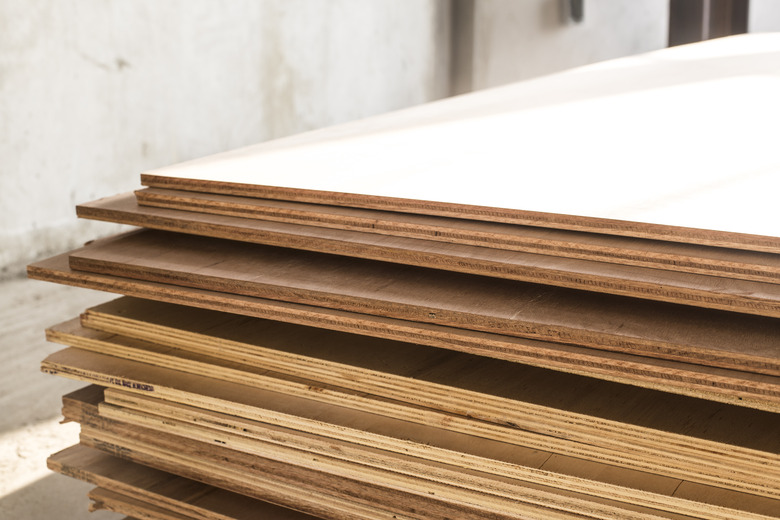How To Weatherize Plywood
We may receive a commission on purchases made from links.
Plywood is a layered and glued wood product used for building houses, sheds, doghouses, and other projects. Indoors or out, construction grade or sanded finish grade, you should weatherize plywood panels to ensure long life under a multitude of conditions. Your choices range from clear sealants and stains to primer and paint.
Facts About Plywood
Facts About Plywood
Plywood isn't waterproof. Some types, such as marine and medium-density overlay (MDO) plywood, are water-resistant but require additional treatment to prevent damage from water and humidity. In general, whether interior- or exterior-grade plywood, a protective coating protects and enhances the aesthetic value of the wood surface.
Plywood is made by gluing thin layers of wood together at a 45- to 90-degree angle. The face veneers range from rough and knotty to nearly knot-free sanded furniture grade, while the interior layers may be aspen, fir, or poplar depending on the manufacturer. Plastic resin glue, or urea-formaldehyde, is used to glue the layers in many types of plywood, while a synthetic polymer called phenolic glue is used for marine plywood due to its moisture-resistant qualities.
While available in various sizes, the most common size is the 4-by-8-foot panel, which is found in thicknesses ranging from 1/8 to 3/4 inch. The thinnest plywood panels may be used for the interior of campers or crafts, while thicker panels may be used for cabinets, siding, or underlayment.
Weatherize Plywood With Clear Sealant
Weatherize Plywood With Clear Sealant
Clear sealants include polyurethane, spar varnish, and oil-based products like Thompson's WaterSeal. Put on gloves, safety goggles, and a mask; then use painter's tape to mask the front and back panels, up to the edges, before adding one or more coats of sealant. Allow the edges to dry for the recommended time, often 30 minutes to one hour; then apply additional coats of the sealant according to the manufacturer's directions.
You can also cover the entire panel — front, back, and edges — with a clear sealant. Clean, sand lightly, and wipe to remove the dust. Then seal the edges and roll, brush, or spray the sealant over the panel, one side at a time, and allow it to dry before adding a second and third layer. In general, work in a sheltered carport or other well-ventilated, sheltered area.
Stain and Seal Plywood
Stain and Seal Plywood
Sealants are also available in transparent, semi-transparent and solid stain formulations. When used on exterior wood or plywood, the stains enhance the wood grain and/or texture of the wood. Choose the appropriate oil- or water-based product for indoor or exterior use; then clean the wood surface thoroughly. Allow to dry completely.
Wait for a dry, windless day when the temperature is between 50 and 95 degrees Fahrenheit. Apply the stain and sealer in a thin coat with a brush, roller, or sprayer. Apply a second thin coat in one to two hours. For best results, apply to both sides and all edges of the plywood.
Paint Plywood Panels
Paint Plywood Panels
Prep plywood panels before painting. If the plywood is construction grade or very knotty, use a compatible oil- or water-based wood filler to fill in any uneven surfaces; then sand the filler and the plywood to a smooth surface before applying paint. Start with 120- or 150-grit sandpaper; then use 220-grit sandpaper. Remove all sanding dust with a dry rag.
Paint the plywood with primer to seal the surface. Brush or roll the primer in the direction of the wood grain to avoid brush strokes. After it's completely dry, add additional wood putty or filler as needed to fill any irregularities in the surface; then sand lightly with 150- or 180-grit sandpaper. Wipe with a dry rag.
For best results and weatherizing, apply two coats of primer; then two to three finish coats of paint, allowing time to dry between coats. While water-based acrylic latex paints are easy to apply and clean up afterward, if you used an oil-based sealant such as Thompson's WaterSeal when preparing the plywood for an exterior project, you must use an oil-based primer and paint.
